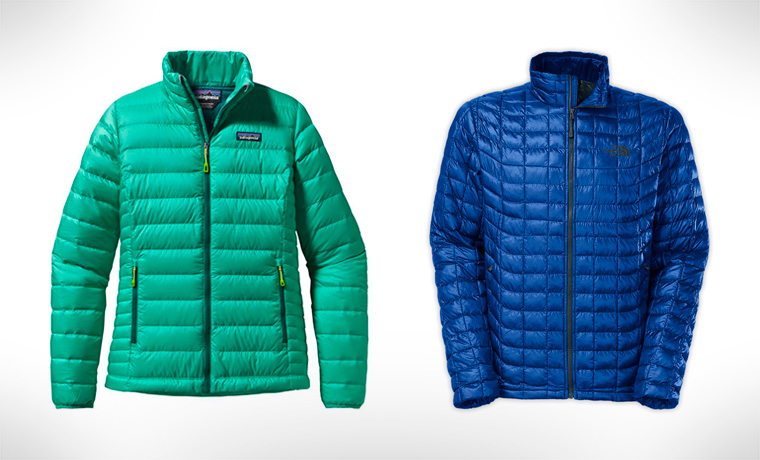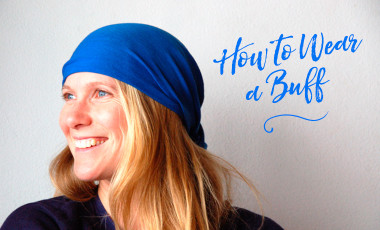As an ever-growing and vast array of brightly coloured insulated jackets enter the outdoor market, trying to decide the best hue to match your skin tones is the least of your worries. Firstly, there are so many different types of insulated jackets to choose from; hooded jackets, pullovers, high neck jackets, short ones, long ones, panelled, quilted, seamless, super puffy, not puffy at all, water resistant, windproof etc etc! And secondly there’s the ever-present battle of down versus synthetic to get your head around.
To help get you a step closer to understanding which type of insulated jacket is for you, here’s a quick guide on what’s great and what’s not for both down and synthetic insulated outdoor gear. So hopefully you’ll only be left figuring out the answer to that all important question of colour after all!
Down versus synthetic
Before we go any further, it’s important to understand that only two options of insulation for outdoor gear are worth considering: goose or duck down and synthetic fabric. Other materials such as merino wool, although very warm in certain outdoor clothing scenarios, just don’t cut it when it comes to lightweight insulation. It really does come down to synthetic versus down.
A simple breakdown of the basic benefits of down and synthetic insulation:
| Why choose down | Why choose synthetic |
|---|---|
| Unparalleled warmth to weight ratio | Performs well when wet |
| Highly compressible | Dries quickly |
| Long lasting | Less expensive than down |
Unfortunately, there’s a little more to the down versus synthetic argument than that; there are a bunch of negatives for both, some serious ethics to consider, and of course your personal preference and what you’ll be using it for. So let’s look a little deeper.
Down
Contrary to popular belief, down is a little different to feathers. Down is the super soft, fine fluffy stuff that sits underneath the tougher outer feathers of birds. Young chicks don’t have feathers at all and only the cosy insulation of their soft down, so it has to be able to do the job excellently. Which, thankfully, it does.
What makes down so effective as an insulator?
The loose structure of down means it works its heated magic by creating loads of tiny pockets between the feathers where air becomes trapped. It is this air that creates a wall of warmth between the user and their outside environment. Of course not all down results in the same degree of insulation. The ‘loftier’ the down, the more air pockets. And the more air pockets, the warmer the result. This is measured in fill power, and the lower the fill power the less effective the down will be as an insulator. For most down sleeping bags and jackets, it’s not really worth looking at anything below 550 fill power.
The upsides of down
- Weight – the biggest bonus of jackets and sleeping bags being filled with ‘feathers’, is that they are incredibly light compared with synthetic filled items. A down sleeping bag of the same temperature rating as a synthetic version will weigh a good deal less.
- Size – the cleverness of relying on air pockets for warmth means that that there is no unnecessary bulk, making down items highly compressible. If it’s a compact sleeping bag or jacket you are after that will also keep you toastie warm, then down is for you.
- Durability – down feathers are highly resilient and, if cared for correctly, can last many years longer than synthetic filled gear. Down harvested from more mature geese or ducks, comes in larger clusters and is therefore more durable than that of younger birds.
The downsides of down
- Moisture – unfortunately, the biggest negative of down is its inability to hold its insulating properties when wet. As soon as moisture reaches the feathers, they stick together and lose their loftiness, massively depleting the number and volume of air pockets. A big deal for outdoor adventurers. Down also takes a much longer time to dry out than synthetic insulation, so if you envisage use of your jacket for wintry and wet wanderings, then go for synthetic.
- Cost – down items are usually more pricey than synthetic. Eiderdown (from ducks) is the most expensive, and the higher the fill power, the steeper the spend.
- Care – washing down gear can be something of a challenge without damaging the fill. However Nikwax has developed a Down Wash which helps with this somewhat.
Some ethics on choosing down
Unfortunately the commercial world of down harvesting has its shady side with many brands sourcing down from companies where the geese are live-plucked. A truly sickening thought. However the more ethically minded brands like Patagonia and Western Mountaineering have altered their policies to totally eliminate the use of down from live-plucked geese. More and more brands are moving in this direction too, but it’s always worth checking. Of course these products often come at a higher price, so if you have a budget then you might consider choosing synthetic to help discourage this inexcusable cruelty.
For more information on what goes on behind the scenes, and what you can do to help, check out this PETA article.

Synthetic
There are a variety of different types of synthetic insulation, but the more common ones are made from polyester. In an effort to mimic the good properties of down, synthetic insulation is made up of tiny polyester fibers of different lengths and thicknesses to trap air between and thus provide warmth. The result is an source of warmth that performs much better than down when wet.
The upsides of synthetic
- Moisture – synthetic insulation deals with getting wet much much better than down as the fibers don’t actually absorb the moisture and so keep their structure better. In fact you can still stay warm when wet (albeit not as warm as when dry!).
- Quick drying – if you do get caught in a downpour, your gear won’t take days to dry like down, and will quickly become totally warm and cosy again given some favourable conditions.
- Cost – most synthetic gear will leave a much smaller dent in your pocket than down gear. The versatility of synthetic insulation also means that there is a wider range of products available to suit different budgets.
- Care – synthetic gear is much more user friendly than down, from this point of view. You can just throw your stuff in the washer and it’s as fresh as a daisy.
The downsides of synthetic
- Weight – probably the most negative feature of synthetic insulated gear is its warmth to weight ratio, making it a less appealing choice for lightweight backpackers.
- Size – when compressed, synthetic gear also tends to be bulkier than down.
- Durability – repeated compression of synthetic gear can damage the fibers over time resulting in a shorter shelf life than down.

Down versus synthetic – the verdict
Well, predictably, there is no right or wrong answer to this conundrum. As you have read, where one fails, the other shines, and it really comes down to what you plan on using your gear for. There are many different scenarios where one would be better suited than the other. It is worth mentioning that most jackets have treated shells to help put up a bit of resistance to moisture, but this in no way makes them waterproof.
Due to the highly compressive nature of down, it tends to loose its loftiness when waterproof layers are worn over the top. Synthetic jackets on the other hand, perform just as well inside an outer layer, making them a little more versatile for those active in the outdoors. So if you live in a climate where the winters are cold and damp then a synthetic insulated jacket is probably for you. Whereas choosing a down sleeping bag, that is less likely to get wet than a jacket, might be a better option than synthetic due to its lightweight and compressible properties.
In the ideal world there would be fully waterproof down jackets available! In fact some companies are developing hydrophobic down where the down is treated to make it water resistant. There’s little evidence to back up its effectiveness yet. But watch this space, a techni-coloured down dreamcoat may be just around the corner!








